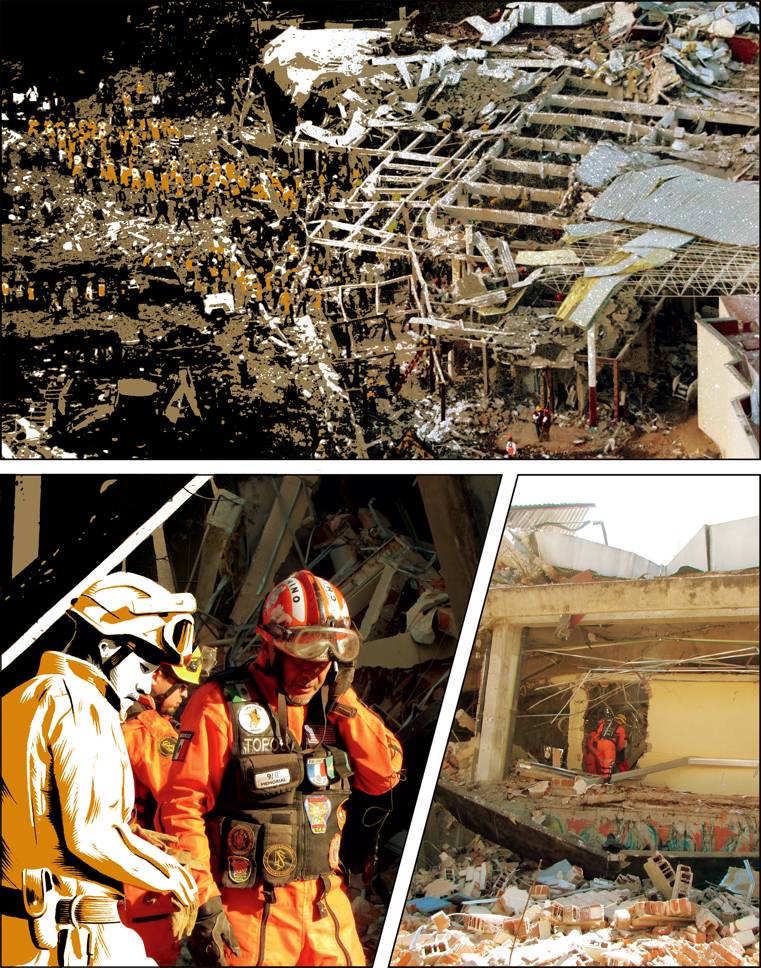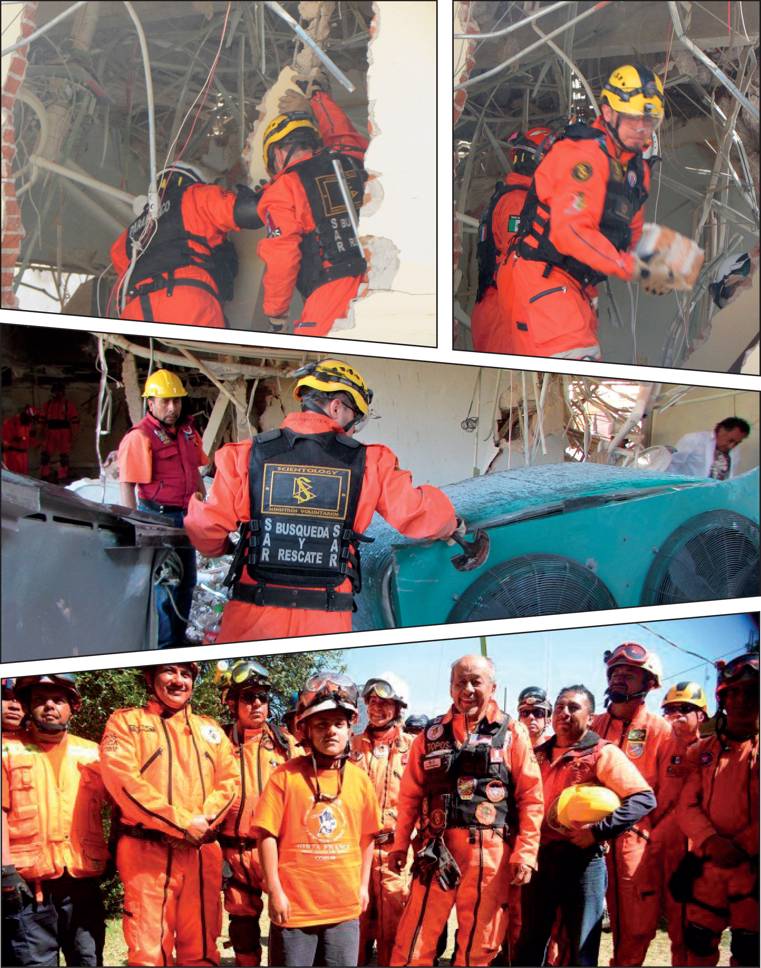Search and Rescue

It was another routine propane delivery to Hospital Materno Infantil Cuajimalpa (Cuajimalpa Maternal Hospital) in Mexico City—at first. But, at 7:20 a.m., the gas pipe feeding the hospital’s kitchen ruptured. For at least 15 minutes, three workers from gas supplier Nieto Express sought to contain the leaking fuel.
Then something—nobody knows what—sparked the propane-filled air. An earth-rattling boom followed, and a giant plume of smoke rose over the hospital. Over half of Cuajimalpa Maternal collapsed, threatening the 110 people inside, many of whom became trapped beneath the rubble. The official toll would stand at three killed, 66 injured, many of them the victims of flying shards of broken glass.
Nearby residents were the first to arrive on the scene to render aid, and initially mistook the blast for an earthquake. Instead, it was Mexico City’s third fatal, large-scale gas explosion in two years. One ripped through the headquarters of petroleum firm Pemex, another wiped out motorists on an open highway. In the wake of the Cuajimalpa disaster, some would call for reconsideration of Mexico City’s heavy reliance on gas-tank and propane deliveries instead of pipelines.
But that was a question for the future. What was needed now was action—and experienced rescuers. Although relief efforts were impeded by heavy traffic, elite search and rescue force Los Topos was on its way, accompanied by two Scientology Volunteer Ministers, Alex Dellano and Daniel Gonzales. (It took three hours to traverse the 40 miles to the site.)
“I was on my way to work when a number of Volunteer Ministers started to send me messages letting me know that the incident had occurred,” Dellano recalls. “A few minutes later I arrived at my office and contacted Hector Mendez to coordinate the meeting point for Topos and Volunteer Ministers to start the disaster response.”
That’s no small compliment to the Volunteer Ministers. Los Topos is an elite unit, born out of the September 19, 1985, earthquake that devastated Mexico City. That day, Hector “Chino” Mendez plunged heedlessly into the danger and chaos, searching for his brother (who would be found alive). Joining forces with other bystanders, Mendez dug for hours. He rescued at least four people from perishing in the ruins.
It was a life-changing experience that impelled Mendez to form “The Aztec Moles” (Los Topos Aztecas). Now simply Los Topos, they go where trouble calls, whether it’s Ground Zero on 9/11 or a demolished cathedral in the 2010 earthquake in Port-au-Prince, Haiti—where the relationship with the Scientology Volunteer Ministers began.

During the Haitian disaster, Los Topos became acquainted with the yellow-shirted Volunteer Ministers and a mutual admiration developed. When Hurricane Manuel struck Acapulco in 2013, nearly 100 Los Topos and Volunteer Ministers joined forces to perform search-and-rescue operations. The two groups also collaborated on disaster relief in Japan, Guatemala, Turkey and the Pemex explosion in Mexico City.
At Cuajimalpa Maternal, the Volunteer Ministers supplemented their yellow shirts with yellow helmets and descended into what remained of the hospital. Their first priority was securing a potentially dangerous piece of medical equipment. “An officer from the federal Mexican police informed us that there might be an X-ray machine on the site that contained cobalt-60, a radioactive and highly poisonous substance,” Dellano recalls.
Rescuers couldn’t take any chances. If the machines they use to sift through the rubble and remove debris were to break apart the machine, it could contaminate the area. “So we were asked by the federal police to find the machine and secure it,” says Dellano. “It was very delicate work, as the overall structure was quite weak. Any misstep could have led to serious injury or death—or accidentally fracturing the device before we were able to secure it.”
Three hours into the painstaking search, Mexico City emergency officials were able to confirm that there was not a cobalt-60 machine on the site “which was of course a relief,” remembers Dellano.
“What we did find was almost total destruction of the hospital,” he continues. “The site became increasingly dangerous as the search and rescue work carried on. There was the risk of total structural collapse, and at one point gas began leaking again,” which caused a secondary fire that took firefighters two hours to contain.
At the peak of the operation, some 2,000 firefighters, Red Cross workers, soldiers, police, and volunteers were deployed at the disaster scene. “We were working in one of the worst and most dangerous places,” says Mendez, although he shrugs off any suggestion of valor: “We are just another volunteer group.”
The search for the cobalt had come to an end, but the work for Los Topos and the Volunteer Ministers was just beginning. “Our duty was to support the operation and secure the scene for other rescuers and workers,” explains Dellano. “Those workers needed to be taken care of, as they were not specifically trained in dealing with collapsed structures. It was our task to ensure those people were safe in doing their job.”
They worked at it all that first day, then long into the night. Temperatures fell to freezing, and they were lightly dressed. Now it was the Topos/Volunteer Minister force that would receive some support—from nearby residents who materialized with food and coffee.
Leading the coffee-distribution effort was an 11-year-old boy named Jonathan Tobon Ruiz. Jonathan, a stocky youth with a thick shock of black hair, lives just down the street from the hospital site, “in a very humble home,” says Dellano.
In the immediate aftermath of the accident, the boy “ran to help, telling his mother he had to do something to help the babies at the children’s hospital,” according to Dellano. “The boy got to the scene before the police, and when officials did arrive, he led them to where he had heard cries and insisted they dig into the rubble, where they found and rescued two small children.”
Dellano and Los Topos later followed up with Jonathan, learning that he was the “man of the house,” helping his single mother to raise his two younger sisters. “His mother told us that the night of the explosion, Jonathan wanted to bring us coffee because he admired us,” says Dellano. “She said that before her son went to bed that night he prayed for us, asking God to watch over us, to keep us warm on such a cold night, and for the walls and the rubble of the collapsed hospital not to fall on us.”
“I was moved to tears,” Dellano says, “and had to step outside to collect myself.”
Hector Mendez asked Jonathan to be an honorary member of their team, and presented the boy with a Los Topos jersey. (Jonathan was later gifted scholarships in recognition of his extraordinary service.)
Back at Cuajimalpa Maternal, the sun came up on the day after the disaster. By late morning on that second day, all the people reported missing in the accident had been accounted for and the rescue force began to thin out, ultimately dwindling to 20 or so Los Topos and Volunteer Minister workers and a few stragglers from other rescue teams.
A few hours later, a crew of about 200 workers arrived to remove rubble and commence cleanup of the scene. The force was made up of general laborers who had no training or experience dealing with unstable structures or any kind of accident site. “This left them very vulnerable,” says Dellano. “What remained of the hospital structure was very weak, and it was difficult and dangerous to move around the scene because of all the debris.”
“We were the only trained rescuers still left on the scene, or anywhere near the area,” Dellano continues. “We felt it was our moral duty to support the workers, advise them where we could on how they could carry out their work with better safety, and just generally look after them.”
Scientology Volunteer Ministers stayed at the site with the clearing crews for two more grueling days. In rare downtime—resting at night or breaking for meals—they took time to counsel the workers, helping them cope with the emotional difficulty of combing through a scene of mass destruction. They also counseled nearby residents traumatized by the explosion and the subsequent chaos.
It was well worth it. “During these three days, people living in the area, people from other rescue teams on site the first day—even policemen—approached us and thanked us for risking our lives to help people we didn’t even know,” Dellano says.
Where disaster strikes, it’s a fair bet that Los Topos and the Volunteer Ministers (who number 1,000 in Latin America) will be there—and perhaps one day little Jonathan Tobon Ruiz will be among their ranks.






























